and Jeffrey T. Reiter2
(1)
Mountainview Consulting Group, Inc., Zillah, WA, USA
(2)
HealthPoint, Seattle, WA, USA
Electronic supplementary material:
The online version of this chapter (doi:10.1007/978-3-319-13954-8_10) contains supplementary material, which is available to authorized users.
Keywords
Start-up checklistBARRIERS to Using BHC (BUB) QuestionnaireBARRIERS to Same-Day Services (BUS) QuestionnaireGATHERRequest of the weekRelapse prevention planPCP RN surveyShadowing note sheetSurvey PCPs and RNsTopics for BH team meetingsSocial service organizationsNewsletterPsychoeducational classPilot studiesTotal barriers scoreBUSBUBNicety to necessityBHC Start-Up ChecklistTeam of one“I have learned that success is to be measured not so much by the position that one has reached in life as by the obstacles which he has had to overcome while trying to succeed.”
Booker T. Washington
There are obstacles related to our history of separating behavioral and physical health treatment that can only be overcome through mindful, day-to-day delivery of integrated services. The new BHC’s challenge is to address these obstacles methodically, as this is of fundamental importance to creating a solid foundation. To support the BHC in this endeavor, we offer the BHC Start-Up Checklist. This is a long checklist; it begins with the first week, and many items continue to be of importance over the course of years of PCBH practice. By following this checklist, the new BHC will begin to develop a new identity different from that of other positions she has held in the past. This identity will include becoming a powerful educator on behavioral health interventions that help patients improve quality of life. Over time, the BHC’s identity will expand to that of a systems wizard, where she strives to initiate change to clinic and patient care processes. Soon she will be able to stand in the shoes of her PCP/RN colleagues, finding ways to help better connect them with the services that she has to offer. Starting strong requires keen attention to many details, and growing stronger requires perspective and perseverance in overcoming obstacles.
BHC Start-Up Checklist
Starting a new job is difficult enough, but starting a new job with a new model of care that is also new to a system is an especially daunting task. What should be done first? Who should be involved in helping? The BHC Start-Up Checklist (Figure 10.1) offers a structure for the new BHC. The checklist contains a list of activities that need attention during the first few months of a service. Even if a BHC service existed previously, this checklist can help ensure an efficient, solid start for a new BHC. We recommend printing Figure 10.1 and using it to track progress during the first few months of work. [All practice support tools provided in this chapter are also available as PDFs on the book website (www.behavioralconsultationandprimarycare.com) for easy printing.] The remainder of this chapter is an elaboration on the checklist’s contents, all of which are also discussed in more detail throughout the book. Remember, all checklist tasks should be completed.
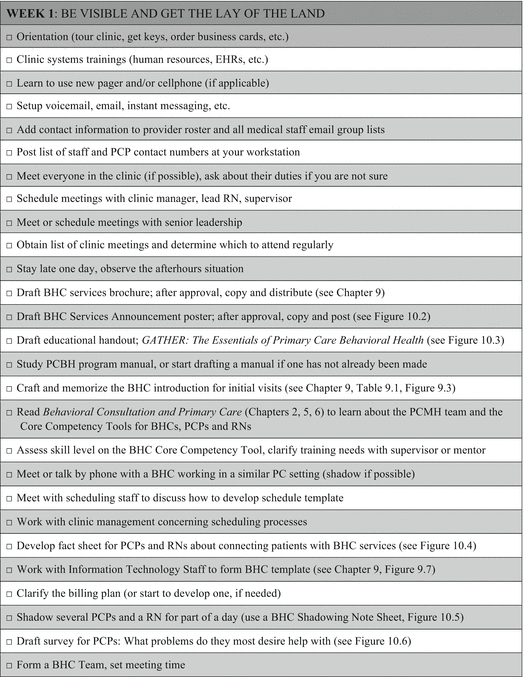
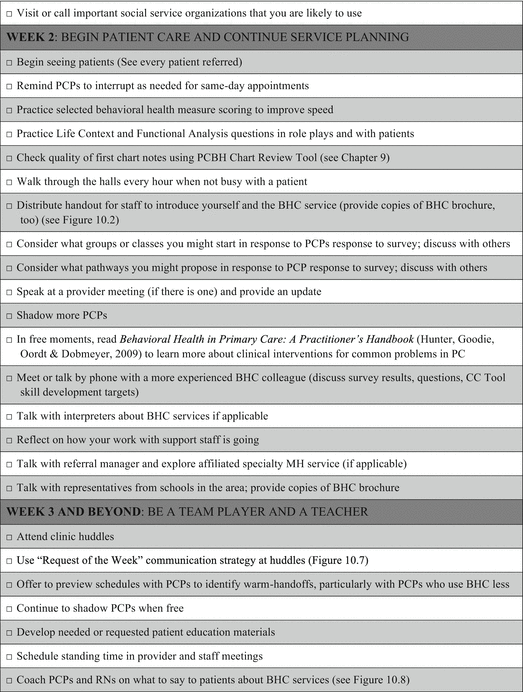
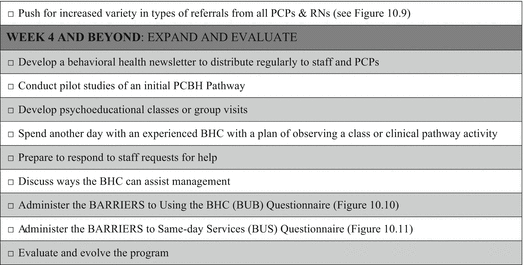



Figure 10.1
The BHC Start-Up Checklist
Week 1: Be Visible and Get the Lay of the Land
An old Chinese proverb will prove useful in your first week: If you wish to succeed, consult three old people. Who are the “old people” that the BHC needs to consult? They include senior providers, particularly those with strong interests in behavioral health, and if possible the senior leaders in the clinic or healthcare system (e.g., the CEO, CFO, other administrators). Relationships with the clinic medical director, the clinic manager, and the director of nursing are also pivotal to success and should be formed early on. During the first week, schedule time with as many of these individuals as possible to discuss the new service. It is also important to locate a more experienced BHC, if possible, and plan to meet or talk by phone. Note that finding someone actually working within an integrated model of the type described here is crucial. Simply finding a MH provider in a PC setting might not be too difficult, but if that person is utilizing a colocated or other type of model, she will probably have a very different approach and philosophy.
Day 1 of the new job will probably involve a tour of the clinic and introductions to staff. Afterward, activities will usually focus on basic orientation. Many, but not all, clinics will have a provider orientation process established. The processes of those that do will probably be geared toward physicians and so may have parts that do not apply to a BHC. Practice patience while explaining repeatedly that you are not a physician (assuming you are not). During orientation, be sure to acquire a staff directory, set up email and voicemail, get keys, order business cards, and learn to use the phone system, instant messaging, and the EHR. Obtain a list of regular clinic meetings from the medical director and/or manager and discuss which ones to attend. Attending at least one of each of the clinical team meetings during the first week or two (e.g., the diabetes team, depression team, or whatever other clinical groups the clinic might have) can be very helpful. Also consider staying late one day, as providers are most likely to have time to talk at the end of the day; staying late will also demonstrate your willingness to work hard, like your PCP colleagues, for whom staying late is a common occurrence. In addition to all of these tasks, be sure to find time for the tasks in the following paragraphs.
Market the BHC Program
Several documents will help you market the BHC program. The first is a BHC program brochure (see Figure 9.1 for content suggestions). This can be a simple single-page document or a more sophisticated trifold. Be sure to include contact information. We also recommend creating a single-page announcement about BHC services that includes your name, contact information, and a photo. Figure 10.2 provides an example of a poster announcing BHC services. It is also important for staff to have a basic understanding of the PCBH model, know the BHC, and know how to access BHC services. For this purpose, we recommend the use of an educational handout such as GATHER: The Essentials of Primary Care Behavioral Health (see Figure 10.3). This GATHER handout provides a mnemonic to help PCPs/RNs learn the most fundamental aspects of the PCBH approach to integrated care.
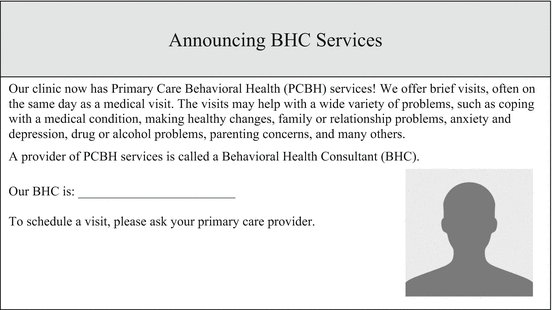
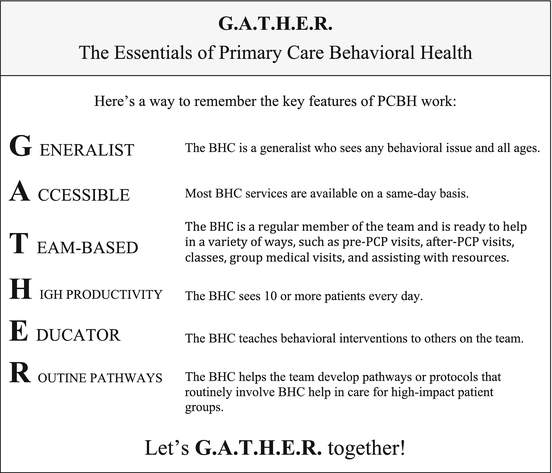

Figure 10.2
Example of poster announcing BHC services

Figure 10.3
GATHER: an example of a BHC educational handout
Study
Study the BHC service manual (if one exists); study Chapters 2, 5 and 6 of this book to learn about the PCMH team and the core competencies of PCPs, RNs and BHCs. Study the interview tools from Chapter 9. Write out the BHC introduction and memorize it. Time yourself to make sure you can say it in less than a minute. Practice getting faster with scoring the behavioral health measures planned for use during all patient visits. When BHCs are fast with scoring, they are more likely to share results with patients during the visit and this better engages patients in care. Complete the BHC Core Competency Tool as a self-assessment; share the results with a more experienced BHC and develop a plan to address identified training needs, if possible. Making arrangements for the BHC mentor to shadow (or be shadowed) is also important.
During the first week, BHCs may also look at areas of interest in books such as Behavioral Health in Primary Care: A Practitioner’s Handbook (Hunter, Goodie, Oordt & Dobmeyer, 2009). This will help the new BHC to learn more about clinical interventions for common problems in PC with which he has limited experience. Between various other start-up activities, try to find 10–15 minutes to learn about an intervention of interest. And remember to ask questions and take every opportunity to learn from your new colleagues; they will likely be eager to share information with you.
Build a Foundation for Referrals
Work with the person who creates schedule templates for providers to learn about the schedule types used in the clinic and assure that BHC appointments are no more than 30 minutes in length. Consider placing a couple of appointments on the schedule that cannot be filled in advance, in order to create some cushion to more easily accommodate warm handoffs. (Remember the goal is for around half of a day’s appointments to be warm handoffs.) The clinic manager and scheduler will help figure out the details, and then it is the BHC’s job to assure the PCPs/RNs know who to refer (“no wrong referrals”), what will happen (“20- to 30-minute visits”), and how to refer (“call the BHC,” “knock on the BHC’s door”). See Figure 10.4 for an example of an educational handout the BHC can use to assist PCPs and RNs in connecting patients with BHC services.


Figure 10.4
Educational handout providing information on connecting patients with the BHC
Prepare for Efficient, Meaningful Charting
Management will likely schedule an orientation to the EHR (if not, be sure to do that!). In addition, ask for a meeting with an information technology manager to discuss content areas for the BHC note template. Share the information from Figure 9.7, and ask what information can be built in. For program evaluation and clinical outcome tracking, ask about building in scoring templates and fields for collecting aggregate data, such as behavioral health outcome measures (e.g., the Duke Health Profile and the Pediatric Symptom Checklist-17). To the extent possible, the goal is a note template that promotes efficiency, as most of the note will need to be completed by the end of a visit.
Clarify the Billing Plan
Clinics vary in their approach to paying for BHC services. Some clinics add BHC services to a per-member-per-month formula based on an assumption of BHC services to a percentage of patients served by the clinic. Other clinics bill for each BHC visit, yet others are funded by grants, and still others assume that offering BHC services provides a medical cost offset and thus invest no time or money in billing. A new BHC needs to know the clinic’s billing plan for BHC services and how to code visits. This should be clear before seeing any patients.
Shadow PCPs and RNs
If possible, shadow every PCP for a couple of hours during the first week or two. Shadowing involves sitting in on patient visits and observing the workflow (in the case of a RN, it may involve listening to a lot of calls). The best practice is to shadow the NA who rooms the patient, and then go in with the PCP for that same patient. The reasons for shadowing are to learn about the types of problems the providers see, the nature of PCP–patient interactions, workflow issues, and ways a new BHC service can be of help. When shadowing, most people simply listen, observe, and make note of what the PCP might need in order to be more effective (e.g., a new screening tool, help with history gathering, knowledge of some simple coping techniques to teach patients, etc.). Because providers vary greatly in their interests, different objectives will become clear for different providers. Some may be eager to learn specific cognitive behavioral interventions, while others will be much less interested in psychosocial issues. For the latter group, one might set an initial goal of simply encouraging them to consistently make referrals.
If a behavioral issue arises when shadowing, be prepared to provide input, but avoid jumping into discussions if not invited. Talking with PCPs beforehand about whether they want you to simply observe or to become selectively active can help guide your approach. Some PCPs may feel anxious being observed so be sure to make clear that the purpose of shadowing is to learn from the PCP, not to judge performance. A BHC Shadowing Note Sheet (see Figure 10.5 for an example) offers a way to record your observations between patient visits. The PCP may invite questions or observations at the end of the shadowing period, but wait for the invitation before starting up an extended discussion. Be sure to thank the PCP for agreeing to be shadowed. For more on shadowing, see also Chapter 3.
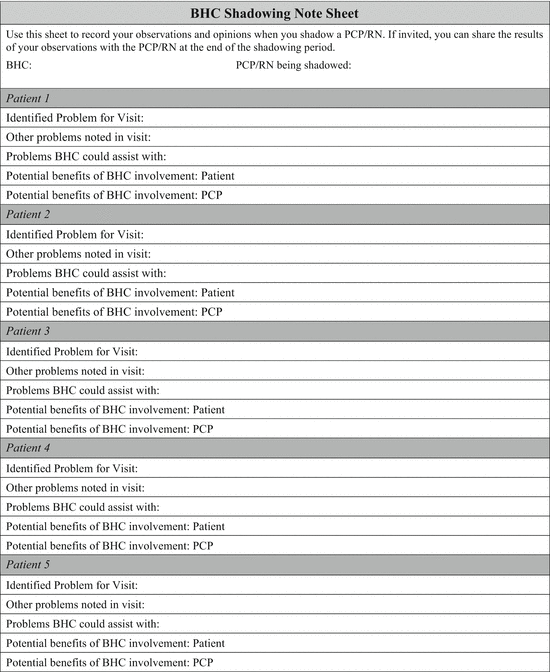

Figure 10.5
Example of a BHC shadowing note sheet
Meet the Team
As noted above, meeting senior leadership is an important activity but so is meeting members of the clinic staff. Understanding the role of each person on the team, and how they can interface with the BHC service, is crucial. Schedule at least brief (10 or 15 minutes) meetings with at least one person who can represent each of the team roles (e.g., front desk, referral coordinator, interpreter, scheduler, NA, lab technician, pharmacist, etc.). Staff will appreciate the attention and interest, making these meetings an important part of developing positive and productive relationships with the team.
Survey PCPs and RNs
Figure 10.6 provides an example of a single-page survey for PCPs and RNs concerning the patients they most want the BHC to see. For a population-based approach, understanding the PCP/RN perspective on patients who exert a high impact on their practice is important. These patients may exert a high impact on the clinic because there are many in the group (e.g., depressed patients) or because of the way they interact with members of the team (e.g., chronic pain patients). Patients who have a pattern of high use of medical services always exert a high impact on PCP and RN practice. The sample survey invites respondents to indicate patient groups that are in need of better outcomes and that have a high impact on PCP’s day-to-day or week-to-week practice. After compiling the data, begin to think through possible pathways (discussed in Chapter 12). Starting one or more pathways is an excellent strategy for growing the BHC practice quickly, as pathways promote the use of BHC services as a part of usual care for members of specific high-impact groups.
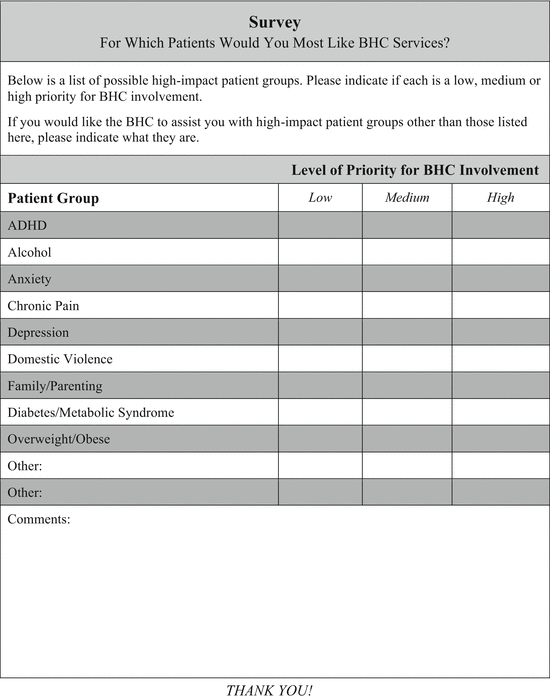

Figure 10.6
Example of a PCP/RN survey concerning patients PCPs/RNs would like BHCs to see
Form a Behavioral Health Team
Laying the groundwork for a behavioral health team should also be accomplished during your first week of practice. The purpose of this team is to help achieve the goals of the PCBH model, as described in Chapter 1. The best behavioral health team members will be those that support these goals and have a history of working effectively as a part of a team. As with Noah’s Ark, try to bring aboard a variety of players. The clinic manager is a critical member, as he will know how to best support new projects. A member of the front desk staff can also be helpful. While the medical director is also a desirable team member, she may decline due to lack of time. Having a PCP champion on the team is crucial for PCP-BHC communications and the development of PCP-friendly services. A champion is one who is especially enthusiastic about the BHC service and likely to promote it vigorously among PCP colleagues.
Nursing staff can also be a critical part of the team. As in the case of the medical director, if the director of nursing is reluctant due to time or other constraints, ask that he designate a member of the nursing staff as a proxy. If a BHA is hired, she should obviously be a member of the behavioral health team. Including a RN or NA can be very helpful for figuring out the nuts and bolts of program implementation.
During the first 2–3 months of a new service, the team should meet weekly if possible. The meetings can be brief (10–15 minutes) and can be added on to other meeting times or perhaps during lunch or first thing in the morning before seeing patients. If this is not possible, try to meet with each team member briefly on a weekly basis or at the very least email them a weekly update of activities and ideas. Frequency of meetings is important in the beginning because many questions will emerge that need quick answers in order for program development to stay on track. However, after the first 2–3 months, the team may meet less frequently. Meetings may become monthly, quarterly, or simply as needed once the service seems to be running smoothly. Table 10.1 presents common topics for behavioral health team meetings. While not all topics need to be covered at every meeting, the team will need to look at all areas at least quarterly. Even within the first month, we recommend that the BHC discuss PCBH pathways with team members, as these offer potent strategies for extending BHC services to a large number of patients (see Chapter 12 for more information on pathways).
Table 10.1
Common topics for BH team meetings
Administrative issues (space, supplies, equipment, billing, development of a program manual, interfacing with other clinic staff, etc.) |
Performance (feedback from patients and providers, efforts to provide educational presentations or documents to providers, etc.) |
Clinical issues (number of referrals from each provider, the ratio of same-day to scheduled visits, the diversity of referral issues, the BHC’s ability to stay on time, etc.) |
Clinical pathway issues (identification of potential target problems, pilot studies to evaluate elements of a pathway, etc.) |
Social Service Organizations
Finally, if time permits during the first week, make a point of visiting local social service organizations including government and nonprofit agencies that help patients find housing, food, transportation, and other basics. Learn what these services do, which patients are eligible, and how services can be accessed. Ask to be placed on an email distribution list, and obtain a handful of brochures. Begin to cultivate personal connections with staff of the most helpful organizations. If there is no time for visiting these organizations during the first week, prioritize it during the second.
What About Seeing Patients?
If entering an established BHC service, patient care might begin after just a day or two of orientation. However, if starting up a new BHC service, there may be no expectations that the BHC see patients during the first week. However, the pressure will almost certainly be on to begin clinical work by the beginning of the second week.
Week 2: Begin Patient Care and Continue Service Planning
The beginning of the second week is the time to start seeing patients and fine-tuning practice support tools and strategies for completing visits in a timely manner. Visits for the first 2–3 weeks are usually scheduled for 1 hour, to allow for time to learn the EHR and clinic workflows. Assure that copies of the BHC brochure are available for initial visits with patients as well as copies of any behavioral outcome measures. Practice of scoring and providing feedback statements helps the BHC become more efficient and effective with these important patient visit activities. Patients will be more likely to see completion of the measures as meaningful if they receive feedback and see the BHC use them in a helpful manner. If helpful, keep copies of the life context questions and the functional analysis questions (see Chapter 9) nearby during initial visits, to improve adherence to the structure of the initial visit. Try charting during the first visits, even if only using radio buttons and drop-down lists. Remember, exposure is the cure for fear of charting during patient contacts, so starting this earlier rather than later is important. Evaluate your first few chart notes with the PCBH Chart Review Tool from Chapter 9.
When not busy, walk through the halls. Let other team members know you are available to assist in a variety of ways, including making calls and drafting letters. Demonstrate that you are a team player. Continue to meet staff and provide copies of the BHC brochure. Reflect on PCP/RN responses to the survey: What groups or classes might be helpful? What are the priorities in terms of starting an initial pathway? Is there a simple pathway that might be acceptable to most PCPs (e.g., offering all patients with more than two chronic diseases a same-day visit with the BHC to talk about a lifestyle goal)? Attend a provider meeting if possible and provide an update on the start of BHC services. Give them ideas about how they can help, based on the experiences of the first couple of weeks. Continue to shadow PCPs/RNs when an hour or more is free. This is a great way to get to know other people on the team and gain a better understanding of how the BHC service can fit into the workflow.
Explore Affiliated Specialty Mental Health Services
At some point during the first two weeks, learn about available specialty MH services and how to refer patients to them. This may involve talking with the referral manager or visiting the colocated specialty MH service, if the clinic has one. The goal is to learn what types of specialty MH services exist and what the common barriers are to patients accessing them. If visiting an affiliated service, one topic of discussion should be coordination of care for shared patients (i.e., those patients seen by the BHC who are also being followed in MH). In particular, establish a point of contact in the most frequently utilized MH agencies, and discuss how information can be efficiently shared.
Week 3: Be a Team Player and a Teacher
At the beginning of the third week, most BHCs will begin to feel a part of the team. They will have a sense for the types of patients they are seeing and be able to identify patient groups that are possibly under-referred. This is the time to start exploring ways to influence PCPs outside of hallway and shadowing encounters. Presentations at provider meetings or lunch hour workshops, written communications (e.g., emails, newsletters, and brief handouts), and professional detailing are powerful teaching strategies. Professional detailing involves brief individual meetings with a PCP to discuss some topic identified a priori by the BHC (e.g., how to interpret Duke Health Profile scores). The third week is when attention turns to developing these tools and strategies.
Huddle with the Team
Stay updated, free articles. Join our Telegram channel

Full access? Get Clinical Tree






